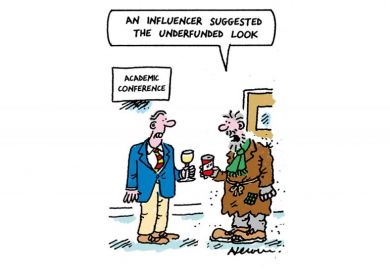
In theory, it seemed like a flawless plan: invest in a company that sells something people literally can’t live without, which has no competitors and customers are compelled to use. So how was the Universities Superannuation Scheme (USS) meant to predict that Thames Water would end up £15 billion in debt, leaving its investment in the ailing utility provider worth next to nothing? The UK higher education sector’s largest pension scheme has now expressed “deep regret” at the situation, as its 20 per cent stake in Thames Water, which was valued at £956 million two years ago, plunged to “minimal” levels. With Thames Water once again seeking investors, let’s hope the USS has learned an elementary financial lesson: if it sounds too good to be true, it probably is.
Students at a New York college were outraged to discover a new protest tent encampment on their campus. More specifically, they were infuriated that the group behind it was not protesting against climate change inaction or the war in Gaza, but were filming a fictional television show. According to the Daily Mail, FBI Most Wanted set up a tent city at City University of New York for two days, complete with “dirty” extras and a fake explosion. Needless to say, the students who had established real encampments earlier in the year, only to be cleared out by police, were unimpressed. “They are not only preventing students from fighting against genocide on their campus, they are financially benefiting from mocking them,” one student said of the university. In the end, the students did what they do best: gathered a group, made some signs and held their own protest against the TV show’s “protest”.
A master’s student has used his coursework as an opportunity to make a point about the controversy surrounding some of the British Museum’s foreign artefacts. Ilê Sartuzi, a Brazilian artist and postgraduate student at Goldsmiths, University of London, swapped a silver coin from 1645 that was being passed around as part of a demonstration with a fake one and dropped the real one into a museum donation box. Mr Sartuzi then exhibited at his university a video of the heist. Richard Noble, head of Goldsmiths’ art department, told The New York Times that the stunt fell “within the remit of what we would term institutional critique” and received a “very high mark” but the museum was less than impressed, describing it as “a disappointing and derivative act”. With curators set on informing the police, Mr Sartuzi will be hoping that he does not end up with a criminal record as well as a degree.
Does the University of California, Los Angeles owe Laura Dern a very overdue apology? The Oscar-winning actor recently revealed that her decision to accept a role in the cult David Lynch film Blue Velvet forced her to drop out of the prestigious institution after just two days. Denied leave of absence to shoot the movie, she showed the (famously explicit) script to the head of the film department – and it did not go down well. “First of all, if you make this choice, you are no longer welcome at UCLA. You’ll be out,” the academic reportedly said. “But secondly, having read this script, that you would give up your college education for this is insane.” Given Ms Dern’s subsequent success, it seems fair to say that she made the right decision – but there’s one thing that still sticks in her craw. “If you want to get a master’s in film at that school, when you write a thesis, there are three movies you are required to study,” she told a podcast. “And you know what one of them is? Pisses me off.”
In need of money because of declining enrolments, the private Indiana institution Valparaiso University made a controversial decision: it would sell off some of its valuable art collection, including a Georgia O’Keeffe landscape. Students and faculty alike protested against the plan; what’s more, because the paintings were purchased via a 1953 donation from Percy Sloan, son of the artist Junius Sloan, the university needs “legal permission” to sell them, The New York Times reported. So Valparaiso has taken an unusual approach: Mr Sloan’s donation stipulated that any art purchased must be “of the general character known as conservative” – and the paintings in question, the university is arguing, are not, and therefore should never have been bought in the first place. The approach has raised eyebrows: “The university is being extremely conservative – that is literal – in its interpretation of Percy Sloan’s trust,” said art historian Wendy Greenhouse.
Register to continue
Why register?
- Registration is free and only takes a moment
- Once registered, you can read 3 articles a month
- Sign up for our newsletter
Subscribe
Or subscribe for unlimited access to:
- Unlimited access to news, views, insights & reviews
- Digital editions
- Digital access to THE’s university and college rankings analysis
Already registered or a current subscriber?



